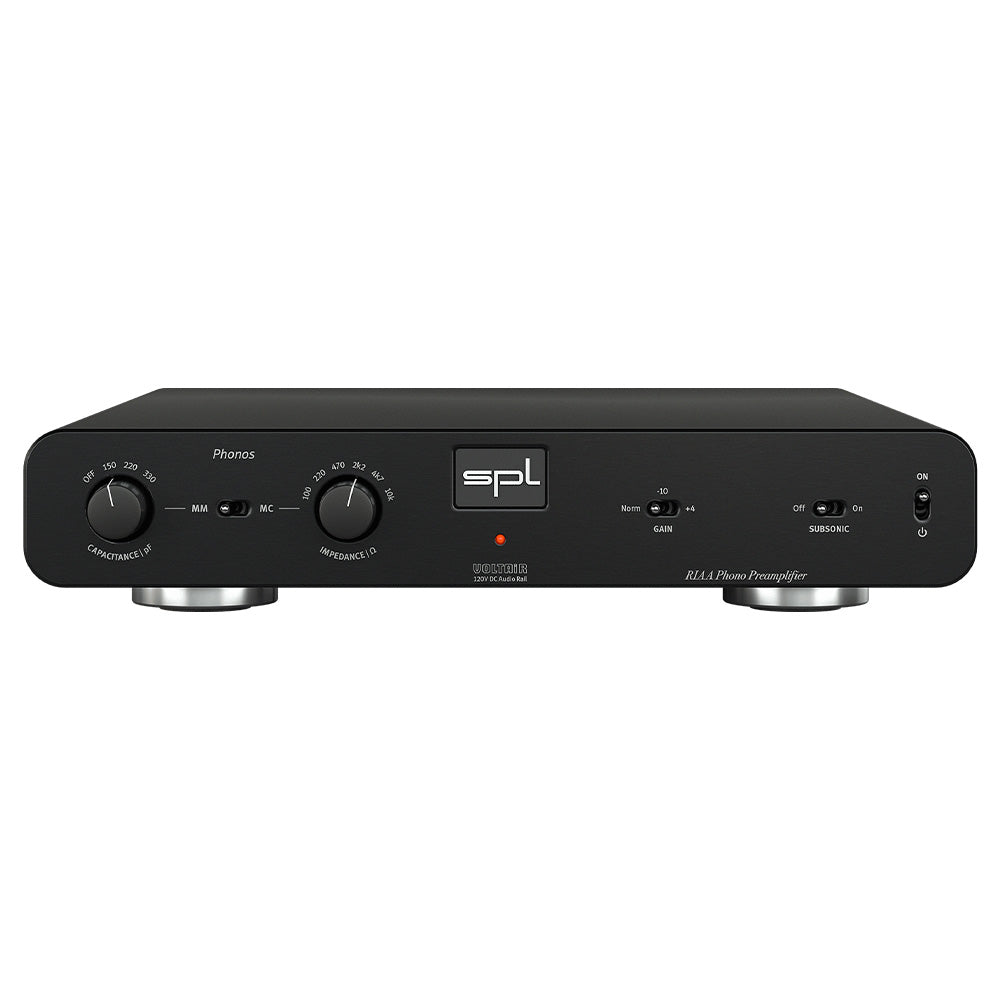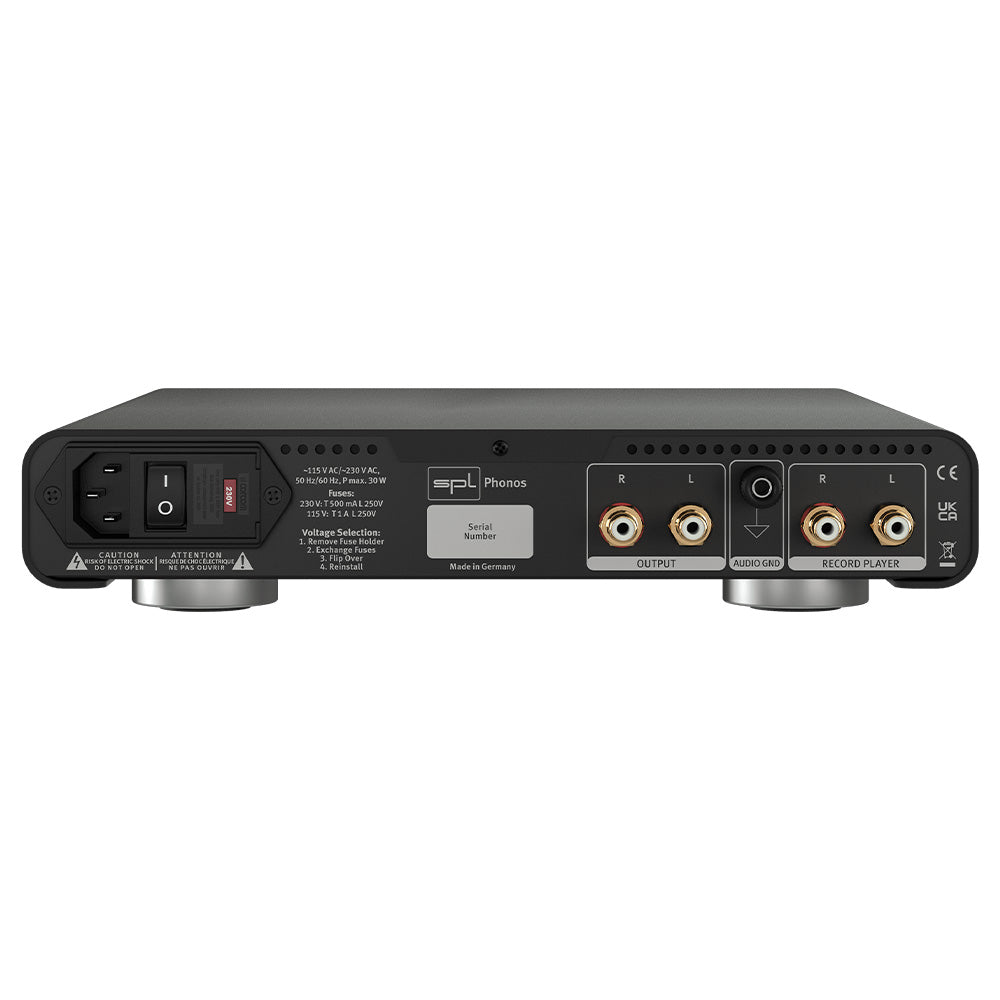
Description
This phono preamplifier for Moving Magnet (MM) and Moving Coil (MC) pickup systems is based on the legendary Douglas-Self-Design.
MM or MC
There are two pickup systems for record players: Moving Magnet (MM) and Moving Coil (MC).
Moving Magnet
Moving magnet pickups generate a small voltage by moving a magnet between copper coils. MM pickups have a very high inductance and impedance. The Phonos offers a choice of three capacitors to correct the linearity of the frequency and phase response. The capacitances are 150 pF, 220 pF and 330 pF. In the off-position the capacitance is determined by the capacitance of the cable.
Moving Coil
The MC pickup is also a small electromagnetic generator, but with the magnets firmly anchored and the coils moving between them, i.e. exactly the opposite of the MM pickup.
The output voltage, however, is very low at only a few hundred microvolts and is therefore more sensitive to noise and induced hum. This makes preamplifier design a challenge, because the very low output voltage must be pre-amplified extremely noise-free. Phonos offers one of the most powerful phono preamplifiers for MC systems with up to 71.5 dB preamplification. Thanks to the 120V technology, the preamplifiers are extremely low-noise, linear and phase-locked.
MC pickups have a very low inductance and impedance.
This means that the effects of cable capacitance (from turntable to preamplifier) are negligible. The impedance, however, is relevant and can be set in six positions: 100, 220, 470, 2.2 k, 4.7 k, and 10 kOhm.
If there is any doubt as to which impedance matches that of the pickup, the impedances can also simply be switched through until the linear frequency response is acoustically determined.
Perfect level
The gain control can be used to determine the amplifier power, in other words, the output level of the Phonos.
There are three values to choose from.
In the "Norm" position, the gain is +46 dB for MM systems and +67 dB for MC systems.
With the switch set to "-10", the gain is reduced by 10 dB (MM = +36 dB, MC = +57 dB). This is optimal in combination with standard HiFi equipment that works with a reference level of -10 dBV.
If the switch is in the "+4" position, the gain is increased by +4 dB (MM = +50 dB, MC = +71 dB).
So the output level is about as loud as that of modern DA-converters at a reference level of 0 dBfs = 15 dBu.
Subsonic Filter
The rumbling of the turntable's drive mechanism is also amplified by the high amplification of the bass range due to RIAA equalization in playback.
The Phonos offers a switchable subsonic filter to remove this rumble.
Connections
Gold-plated RCA sockets are available for connecting the turntable and for outputting to a preamplifier such as the Director Mk2 or the Elector.
A ground connection for the turntable is designed as banana plug socket. The ground lead can be either clamped or plugged in.
Sounds good
With all devices of the Professional Fidelity series we develop not only according to plan, but also by ear. Many important components are installed on the circuit boards using Through-hole technology. This way we can ensure that we can use the best sounding components.
RIAA Equalization
RIAA equalization is a specification for the recording and playback of records proposed by the Recording Industry Association of America (RIAA). The RIAA equalization curves introduced a global de facto industry standard for vinyl records in 1954.
RIAA equalization uses pre-emphasis to reduce low frequencies and boost high frequencies when the record is cut (blue RIAA curve). The bass is reduced by up to 20 dB to provide more space and longer record play time. The high frequencies are boosted by up to 25 dB to increase the signal-to-noise ratio between the noise of the record media to the audio signal.
During playback, exactly the opposite happens in the Phonos. The de-emphasis filter (red RIAA curve) compensates for the pre-emphasis and the result is a linear frequency response.
Douglas Self Design
The RIAA equalization of the Phonos was developed according to the recommendations of Douglas Self.
Idea: Many small capacities instead of a few large capacities.
Advantages: The capacitors charge and discharge faster, which results in better resolution and faster impulse response.
Only audiophile Styroflex capacitors are used in the entire RIAA equalizer.
About the person: Douglas Self is a British electronics engineer with a strong penchant for audio. He holds honorary degrees from Cambridge University and teaches psychoacoustics at the University of Sussex.
The VOLTAiR Technology
The 120V technology is our reference technology. The 120V technology is unique in the world. It operates at a DC voltage of 120 volts. This is four times that of IC-based semiconductor op-amps. In our Professional Fidelity series, we refer to this unsurpassed technology as VOLTAiR technology.
The highest possible audio quality requires the highest possible audio operating voltage.
The 120V technology works with +/-60 V. To be able to handle such a high voltage, we have developed special proprietary operational amplifiers that can operate with a DC voltage of +/-60 V: the SPL 120V SUPRA operational amplifiers.
This high voltage would destroy conventional components and operational amplifiers.
By the way, the "120V" in the name of the technology has nothing to do with the local mains voltage from the mains power socket. This is about the operating voltage inside the device with which the audio signals are processed.
The mains voltage from the mains power socket is transformed to the required secondary voltage in the device's internal linear power supply with toroidal transformer. Rectifiers convert this AC voltage into DC voltage required in the audio device.
| Analog Input / Output | |
| Connection Type | RCA |
| Input impedance (MM) | 47 k? |
| Input impedance (MC) | switchable |
| Output impedance | 75 ? |
| Frequency range (-3 dB) | 4 Hz Ð 300 kHz |
| Crosstalk (1 kHz) | -80 dBu |
| Moving Magnet (MM) Preamplifier | |
| Amplification (Norm) | 46 dB |
| Amplification (-10 dB) | 36 dB |
| Amplification (+4 dB) | 50 dB |
| Capacitance (switchable) | Off, 150 pF, 220 pF and 330 pF |
| Noise (A-weighted; 46 dB amplification) | -85.3 dBu |
| Dynamic range | 131.3 dB |
| Moving Coil (MC) Preamplifier | |
| Amplification (Norm) | 67 dB |
| Amplification (-10 dB) | 56 dB |
| Amplification (+4 dB) | 71.5 dB |
| Impedance (switchable) | 100 ?, 220 ?, 470 ?, 2.2 k?, 4.7 k?, 10 k? |
| Noise (A-weighted, 67 dB amplification) | -61.7 dBu |
| Dynamic range | 128.7 dB |
| Internal Linear Power Supply with Shielded Toroidal Transformer | |
| Operating voltage for analog audio | +/- 60 V |
| Operating voltage for relays and LEDs | + 12 V |
| Mains Power Supply | |
| Mains voltage (selectable, see fuse chamber) | 230 V AC / 50; 115 V AC / 60 Hz |
| Fuse for 230 V | T 500 mA |
| Fuse for 115 V | T 1 A |
| Power consumption | max. 30 VA |
| Stand-by power consumption | < 0,3 W |
| Physical | |
| Dimensions W x H x D (width x height incl. feet x depth) | 278 x 100 x 300 mm 11 x 4 x 11.81 inch |
| Unit weight | 3.2 kg 7.05 lbs |
| Shipping weight (incl. packaging) | 4.3 kg 9.48 lbs |
This phono preamplifier for Moving Magnet (MM) and Moving Coil (MC) pickup systems is based on the legendary Douglas-Self-Design.
MM or MC
There are two pickup systems for record players: Moving Magnet (MM) and Moving Coil (MC).
Moving Magnet
Moving magnet pickups generate a small voltage by moving a magnet between copper coils. MM pickups have a very high inductance and impedance. The Phonos offers a choice of three capacitors to correct the linearity of the frequency and phase response. The capacitances are 150 pF, 220 pF and 330 pF. In the off-position the capacitance is determined by the capacitance of the cable.
Moving Coil
The MC pickup is also a small electromagnetic generator, but with the magnets firmly anchored and the coils moving between them, i.e. exactly the opposite of the MM pickup.
The output voltage, however, is very low at only a few hundred microvolts and is therefore more sensitive to noise and induced hum. This makes preamplifier design a challenge, because the very low output voltage must be pre-amplified extremely noise-free. Phonos offers one of the most powerful phono preamplifiers for MC systems with up to 71.5 dB preamplification. Thanks to the 120V technology, the preamplifiers are extremely low-noise, linear and phase-locked.
MC pickups have a very low inductance and impedance.
This means that the effects of cable capacitance (from turntable to preamplifier) are negligible. The impedance, however, is relevant and can be set in six positions: 100, 220, 470, 2.2 k, 4.7 k, and 10 kOhm.
If there is any doubt as to which impedance matches that of the pickup, the impedances can also simply be switched through until the linear frequency response is acoustically determined.
Perfect level
The gain control can be used to determine the amplifier power, in other words, the output level of the Phonos.
There are three values to choose from.
In the "Norm" position, the gain is +46 dB for MM systems and +67 dB for MC systems.
With the switch set to "-10", the gain is reduced by 10 dB (MM = +36 dB, MC = +57 dB). This is optimal in combination with standard HiFi equipment that works with a reference level of -10 dBV.
If the switch is in the "+4" position, the gain is increased by +4 dB (MM = +50 dB, MC = +71 dB).
So the output level is about as loud as that of modern DA-converters at a reference level of 0 dBfs = 15 dBu.
Subsonic Filter
The rumbling of the turntable's drive mechanism is also amplified by the high amplification of the bass range due to RIAA equalization in playback.
The Phonos offers a switchable subsonic filter to remove this rumble.
Connections
Gold-plated RCA sockets are available for connecting the turntable and for outputting to a preamplifier such as the Director Mk2 or the Elector.
A ground connection for the turntable is designed as banana plug socket. The ground lead can be either clamped or plugged in.
Sounds good
With all devices of the Professional Fidelity series we develop not only according to plan, but also by ear. Many important components are installed on the circuit boards using Through-hole technology. This way we can ensure that we can use the best sounding components.
RIAA Equalization
RIAA equalization is a specification for the recording and playback of records proposed by the Recording Industry Association of America (RIAA). The RIAA equalization curves introduced a global de facto industry standard for vinyl records in 1954.
RIAA equalization uses pre-emphasis to reduce low frequencies and boost high frequencies when the record is cut (blue RIAA curve). The bass is reduced by up to 20 dB to provide more space and longer record play time. The high frequencies are boosted by up to 25 dB to increase the signal-to-noise ratio between the noise of the record media to the audio signal.
During playback, exactly the opposite happens in the Phonos. The de-emphasis filter (red RIAA curve) compensates for the pre-emphasis and the result is a linear frequency response.
Douglas Self Design
The RIAA equalization of the Phonos was developed according to the recommendations of Douglas Self.
Idea: Many small capacities instead of a few large capacities.
Advantages: The capacitors charge and discharge faster, which results in better resolution and faster impulse response.
Only audiophile Styroflex capacitors are used in the entire RIAA equalizer.
About the person: Douglas Self is a British electronics engineer with a strong penchant for audio. He holds honorary degrees from Cambridge University and teaches psychoacoustics at the University of Sussex.
The VOLTAiR Technology
The 120V technology is our reference technology. The 120V technology is unique in the world. It operates at a DC voltage of 120 volts. This is four times that of IC-based semiconductor op-amps. In our Professional Fidelity series, we refer to this unsurpassed technology as VOLTAiR technology.
The highest possible audio quality requires the highest possible audio operating voltage.
The 120V technology works with +/-60 V. To be able to handle such a high voltage, we have developed special proprietary operational amplifiers that can operate with a DC voltage of +/-60 V: the SPL 120V SUPRA operational amplifiers.
This high voltage would destroy conventional components and operational amplifiers.
By the way, the "120V" in the name of the technology has nothing to do with the local mains voltage from the mains power socket. This is about the operating voltage inside the device with which the audio signals are processed.
The mains voltage from the mains power socket is transformed to the required secondary voltage in the device's internal linear power supply with toroidal transformer. Rectifiers convert this AC voltage into DC voltage required in the audio device.
| Analog Input / Output | |
| Connection Type | RCA |
| Input impedance (MM) | 47 k? |
| Input impedance (MC) | switchable |
| Output impedance | 75 ? |
| Frequency range (-3 dB) | 4 Hz Ð 300 kHz |
| Crosstalk (1 kHz) | -80 dBu |
| Moving Magnet (MM) Preamplifier | |
| Amplification (Norm) | 46 dB |
| Amplification (-10 dB) | 36 dB |
| Amplification (+4 dB) | 50 dB |
| Capacitance (switchable) | Off, 150 pF, 220 pF and 330 pF |
| Noise (A-weighted; 46 dB amplification) | -85.3 dBu |
| Dynamic range | 131.3 dB |
| Moving Coil (MC) Preamplifier | |
| Amplification (Norm) | 67 dB |
| Amplification (-10 dB) | 56 dB |
| Amplification (+4 dB) | 71.5 dB |
| Impedance (switchable) | 100 ?, 220 ?, 470 ?, 2.2 k?, 4.7 k?, 10 k? |
| Noise (A-weighted, 67 dB amplification) | -61.7 dBu |
| Dynamic range | 128.7 dB |
| Internal Linear Power Supply with Shielded Toroidal Transformer | |
| Operating voltage for analog audio | +/- 60 V |
| Operating voltage for relays and LEDs | + 12 V |
| Mains Power Supply | |
| Mains voltage (selectable, see fuse chamber) | 230 V AC / 50; 115 V AC / 60 Hz |
| Fuse for 230 V | T 500 mA |
| Fuse for 115 V | T 1 A |
| Power consumption | max. 30 VA |
| Stand-by power consumption | < 0,3 W |
| Physical | |
| Dimensions W x H x D (width x height incl. feet x depth) | 278 x 100 x 300 mm 11 x 4 x 11.81 inch |
| Unit weight | 3.2 kg 7.05 lbs |
| Shipping weight (incl. packaging) | 4.3 kg 9.48 lbs |
Your home for all things pro audio—backed by expertise and experience. Connect with us today.
Your home for all things pro audio—backed by expertise and experience. Connect with us today.



